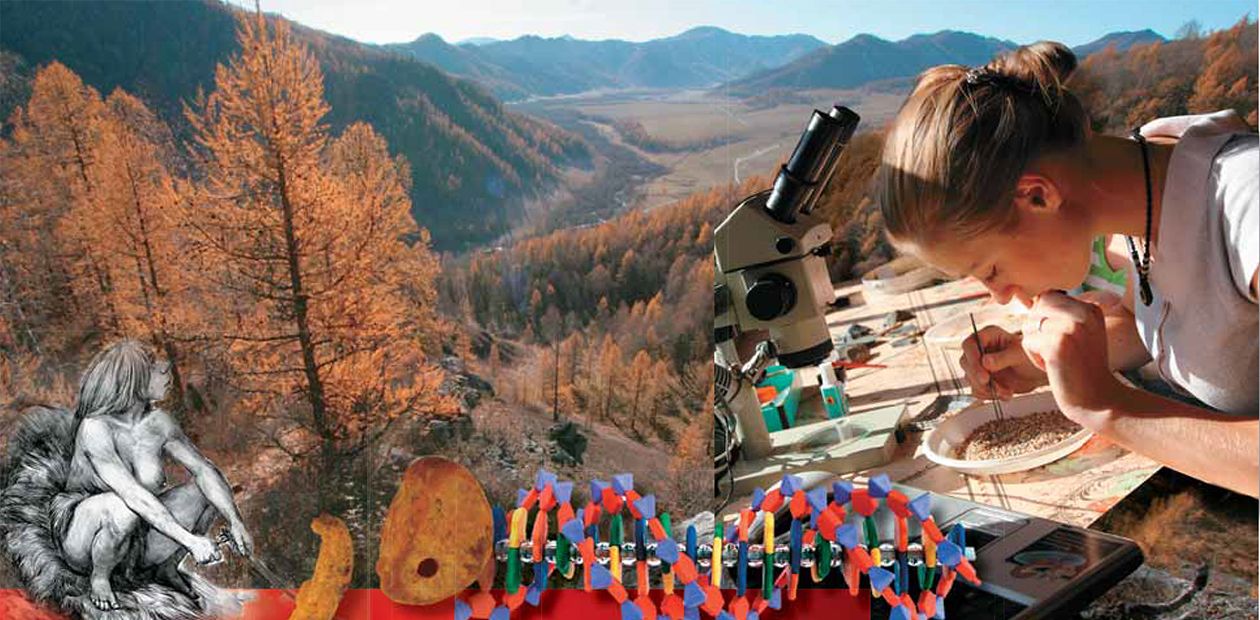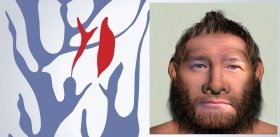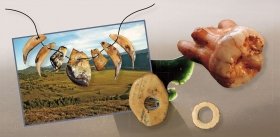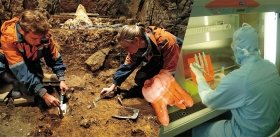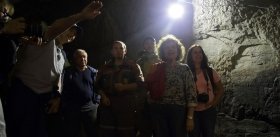On the Time Axis
Multidisciplinary research, the main subject of the symposium, is one of the latest trends in the modern archaeology. Previously, archaeologists were “armed” mostly with a shovel, a brush, and a sharp eye, but today they have a range of natural-science techniques at their disposal. This is a way for archaeology to become an exact rather than descriptive field of science. Objective information obtained within the approach helps interpret the already known archaeological phenomena and get truly sensational results. This is proved by the latest discoveries on the origin and evolution of man. Thus, choosing Akademgorodok as a venue for the symposium appears to be symbolic because, according to Mikhail Fedoruk, Rector of Novosibirsk State University, multidisciplinary research is Akademgorodok's principal advantage: all research laboratories are located “in the walking distance.”
The forum participants, among whom there were geneticists, geologists, and physicists as well as archaeologists, discussed a range of questions about the use of the latest methods and technologies of natural sciences in archaeological research. They include radiocarbon dating, X-ray tomography for analyzing anthropological material, geophysical techniques for studying archaeological sites, and paleogenetic methods, which shed light both on the history of migrations of modern peoples and the origin of humanity.
In an interview for Science First Hand, the forum participants shared their opinions on today’s archaeology and its future in terms of a greater integration with other areas of scientific knowledge:
Anatoly P. Derevyanko, Academcian of the Russian Academy of Sciences, Research Director of the Institute of Archaeology and Ethnography SB RAS, Head of the Chair General History Department, Humanities Department, Novosibirsk State University, Rector of Novosibirsk State University in 1980-1982:
“The hypothesis of the ‘linear’ evolution of man, which had dominated in science till the end of the 1980s, fell apart when scientists obtained data on the mitochondrial and, later, nuclear fossil DNA sequencing. The decoding of the genome of Homo denisova and identification of a new human subspecies came along with the genetic “rehabilitation” of the Neanderthal man, who had been excluded from the human genealogy. The huge anthropological material from Eastern and South East Asia, although unsuitable for paleogenetic analysis, definitely shows that the local hominids participated in the formation of the anatomically modern humans.
Here important is not only the percentage of Denisovan’s genes in the gene pool of the modern peoples of South East Asia but the very fact of his existence. According to modern paleogeneticists, genomes are able to transform rapidly and strikingly because of mass migration processes and crossbreeding of the population. The percentage that remained intact is indisputable evidence of hybridization. It is amazing that a small segment (about 2 to 3%) of Denisovan's nuclear genome belongs to the even more ancient hominid, yet unidentified by modern science.
Mikhail V. Shunkov, Doctor of History, Director of the Institute of Archaeology and Ethnography SB RAS, Associate Professor, Chair of Archaeology and Ethnography, Department of Humanities, Novosibirsk State University:
“The aim of our symposium is to obtain new fundamental knowledge, which can arise only at the junction of different fields of science, i.e., in interdisciplinary research. When a result is supported by data obtained by integrated scientific efforts, the academic community would accepts it as an incontestable fact.
For example, even the newest archaeological techniques would not allow us to properly evaluate the results obtained in Denisova Cave. When we found the unique artifacts and adornments made of bone and stone, while studying the layers corresponding to the transition to the Upper Paleolithic, we were sure that these items were made by Homo sapience because at that time, the Neanderthals were considered a blind branch of human evolution unable to create such items. We also had archaeological data contradicting the hypothesis of “aliens” from Africa and suggesting that this Upper Paleolithic culture was gradually developing in the local context for thousands of years. When the paleogenetics research proved that we had a completely different human population, it became a sensation for the world scientific community, and we were able to solve the accumulated data conflicts.
The chronological data obtained by means of radiocarbon dating at the Oxford University, where there is one of the most well known laboratories conducting radiocarbon analysis, confirm that the Gorny Altai sites are the most ancient ones among the Paleolithic sites known for today. Homo denisova, who inhabited this area, had been able to create the typical Paleolithic artifacts and adornments 15,000--20,000 years earlier than the anatomically modern humans that settled in Europe.
Alexander S. Pilipenko, Candidate of Biology, Institute of Cytology and Genetics SB RAS:
Our ethnogenetic reconstructions of the populations who inhabited the south of West Siberia from the Neolithic to the late Middle Ages are by now based on the mitochondrial DNA data. The analysis of this relatively small part of the genome, which is inherited only maternally, allows us to backtrace a number of important parameters, including the level of migrations. The significant “shifts” in this DNA structure suggest that the entire population was engaged in migration, including women, its most “conservative” element.
The “opposite” example may be the so called Andronovo population of West Siberia, on which there is a lot of well-documented archaeological and anthropological evidence. In this case we were not able to identify the obvious mitochondrial DNA migration markers, but even the very first data analysis of the male Y-chromosome of nuclear genome gives reasons to believe that an alien male population was massively engaged in marriage ties with local women. Such a combination of the mitochondrial DNA analysis and most informative segments of the nuclear DNA gives a not too “expensive” opportunity to backtrace the actual demographic processes in ancient populations.
Natalia V. Polosmak, Corresponding Member of the Russian Academy of Sciences, Chief Researcher, Institute of Archaeology and Ethnography SB RAS:
The multidisciplinary research in archaeology becomes quite often a key to many previously unsolvable problems. For example, the important method of analogies, which is widely applied in archaeology, often misleads researchers. Similar looking items may differ in the time of manufacture and origin. It is necessary to first identify materials, then to reconstruct the technological processes that were used to manufacture an artifact, and then to finally trace its real history. The multidisciplinary approach is also highly relevant when studying the burial mounds left by nomadic peoples, who are known to be rich mostly because of successful military campaigns, pillage, and trade, not because of their own achievements in household goods, luxury items, and weapons.
However, in all our research activities from the study of ancient mummies to nomadic burial inventory reconstructions, we always try to apply a whole range of modern methods offered by natural sciences. This trend is primarily attributed to the complexity and ambiguity of the objects under study, since the terms ancient and primitive are not identical.
We cooperate on a regular basis with the majority of SB RAS research institutes, such as the Central Siberian Botanical Garden, Institute of Cytology and Genetics, International Tomography Center, Novosibirsk Institute of Organic Chemistry, Institute of Nuclear Physics, Institute of Petroleum Geology and Geophysics, etc.
We use the latest techniques and approaches to study household items, substances, and human remains. This is a paradox of the multidisciplinary approach in archaeology: it is necessary to combine efforts of different modern sciences to study one single object. Only a deep and direct contact with an ancient item in the process of multidisciplinary research gives an opportunity to see the culture of the bygone era as it was: the culture of consummate mastery, experience, and knowledge about nature as a comprehensive whole.
We are often too concentrated on political and social history—how peoples and tribes moved and settled, what wars they led, who won those wars and who was conquered—and pay little attention to the imperceptible work that is not recorded in written sources yet went on within the society all that time, for centuries, to give us our Civilization as it is. Unsurpassed masters created the world of human culture. Those deep mysteries that were known to ancient people are now the subject of multidisciplinary research.
The history of Homo sapience is getting more and more “ancient” as the origin of culture achievements is fading in the darkness of the past. All we are able to do now is to study human activities and their results by all available means and to dream about further flashes of inspiration…
Vyacheslav I. Molodin, Academician of the Russian Academy of Sciences, Deputy Director, Institute of Archaeology and Ethnography SB RAS, Professor of Archaeology and Ethnography, and Head of the Laboratory of Eurasian Primeval Art Multidisciplinary Research, Novosibirsk State University:
“It should be mentioned that Novosibirsk State University is one of the organizers of the archaeological symposium dedicated to integrated research in archaeology. Recently, within the framework of the joint project with the French National Center for Scientific Research (CNRS) there was established the mirror laboratory ‘Multidisciplinary Research of Eurasian Primeval Art.’ It is assumed that 3D modeling of unique archaeological objects will be carried out as potential exhibits for virtual museums. According to the work schedule, the first expedition is already moving to Altai to study rock paintings.
All this work is conducted in line with the traditions laid down by the founders of the Novosibirsk Science Center. It is to remind that the Humanities Department of Novosibirsk State University was initiated by academician Alexei P. Okladnikov, our famous archaeologist, historian and ethnographer, who was among the founders of the Institute of Archaeology and Ethnography SB RAS. The Humanities Department was closely integrated into the system of science from the very beginning. The major part of the academic staff are researchers working at SB RAS institutes, and lectures are delivered by the top-level professionals. As regards archaeology, its first Department Head was Okladnikov, and today it is headed by Academician Derevyanko.
Novosibirsk State University adopted the system of obligatory field practical training, which is unique for our country. Students who choose archaeology as their major take part in specialized expeditions where they get in touch with the “inner workings” on their own experience. It is of utmost importance because books depict archaeology as a romantic profession while in reality, besides fireplace songs, it is full of hard work, including physical effort, with midges, mosquitoes, and botflies as an inevitable part of “field romantics.” Nevertheless, young people, who are intelligent, educated, and well-read, go into archaeology. In this context, personally I am sure of the future of our science because it is constantly supported by the flow of talented youth.”
Being one of the top scientific breakthroughs over the last two years, the discovery of the Denisovan has become, according to Science, another convincing argument in favor of the integrated multidisciplinary approach as applied to archaeological and historical phenomena. Students of Novosibirsk State University have a unique opportunity to learn methods of scientific research both in auditoriums and in “live” research projects and expeditions.
Thus, there will be enough discoveries for everyone, after all, according to George Bernard Shaw, “science never solves a problem without creating ten more.”


